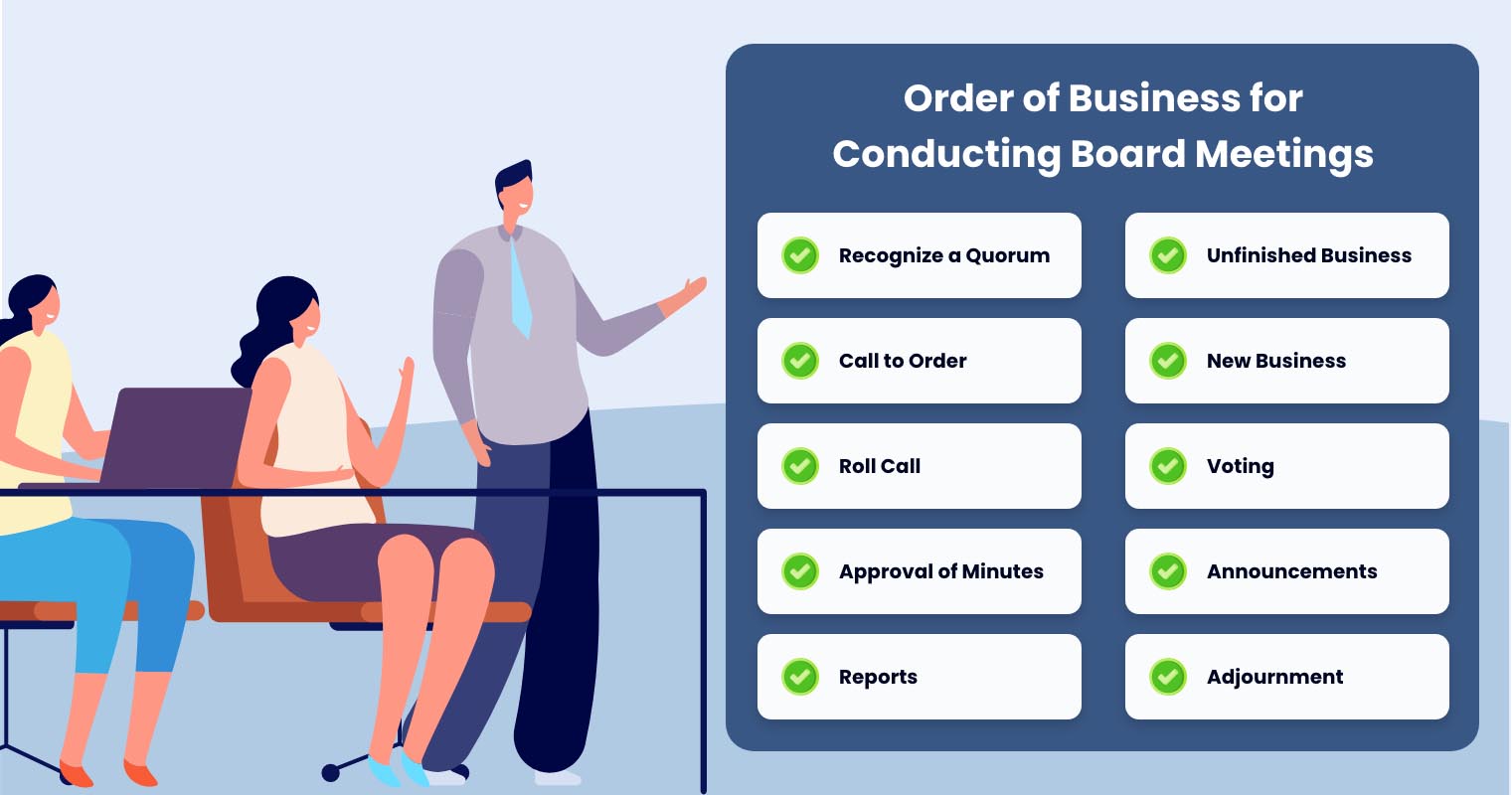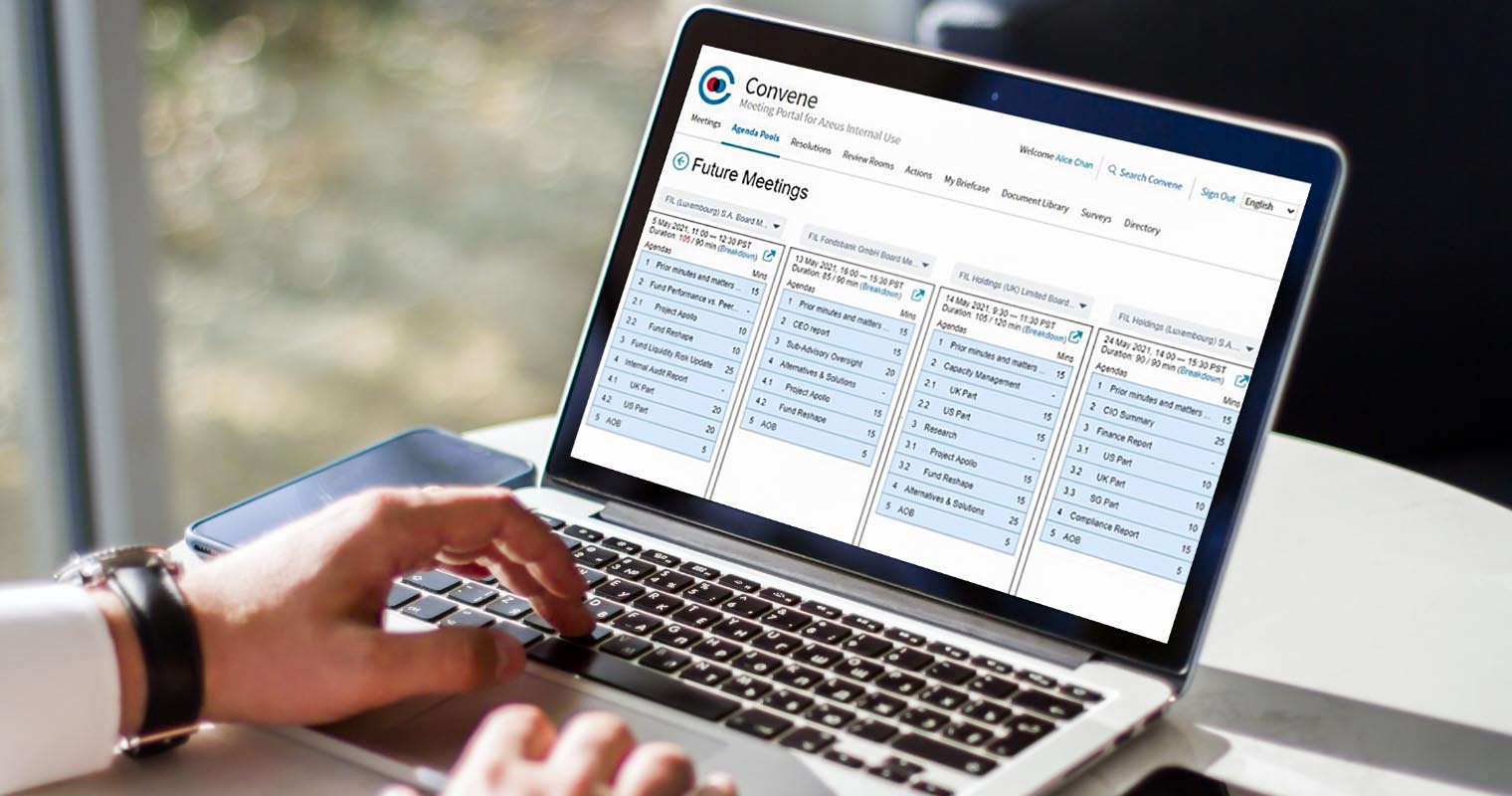In today’s dynamic environment, the importance of board meetings cannot be overstated. Board meetings serve as the crucial platform where these leaders convene to discuss, deliberate, and make critical decisions that shape their businesses’ futures.
In this guide, you will learn everything you need to know when conducting board meetings, from the discussion points to the best practices.
How to Run a Board Meeting
Running well-prepared meetings decides the outcomes of the board’s collaborative efforts, from reviewing performance to addressing company-wide concerns. While priorities for each organization vary, there are some core topics you should include in your meeting discussions.
Essential Discussion Points for Board Meetings

- Operational updates — These discussions involve reviewing and sharing information about the organization’s current operations, progress on strategic goals, challenges, and opportunities. It may include updates on sales figures, production targets, or customer satisfaction rates.
- Key performance indicators (KPIs) — KPI discussions focus on evaluating the organization’s performance against established metrics. It involves analyzing data to assess progress, identify areas of improvement, and make data-driven decisions. KPIs may include financial metrics, customer retention rates, or employee productivity.
- New and current initiatives — This explores new projects, programs, or initiatives being considered by the organization. These initiatives may involve launching new products, expanding into new markets, or implementing sustainability projects.
- Board oversight — This entails addressing matters related to the board’s governance and oversight responsibilities. It involves reviewing financial statements, budgets, internal controls, and compliance with legal and regulatory requirements. Additionally, it may include discussing the appointment of auditors and reviewing board policies.
- Stakeholder relations — These are strategies and activities related to engaging with stakeholders. It includes evaluating and managing relationships with partners, clients, or community members. This may involve discussions on fundraising, partnership opportunities, or community engagement initiatives.
- Risk management — This involves assessing potential risks and developing strategies to mitigate them. Identify, analyze, and address risks related to various areas of the organization, such as cybersecurity, market volatility, or operational disruptions.
- Legal and compliance matters — This focuses on the legal and regulatory compliance issues of the organization. It involves ensuring adherence to laws, regulations, and ethical standards. Other discussions may include data privacy, employment laws, industry-specific regulations, or any changes in legal requirements.
Take note that these topics may vary depending on the organization’s unique circumstances, size, and industry. Make sure to focus on the right topics so you have the most productive discussions.
Order of Business for Conducting Board Meetings

Besides knowing the right topics to discuss, conducting an orderly meeting is imperative. The Order of Business for conducting board meetings typically follows a specific structure to ensure an organized and productive meeting. Here’s the step-by-step process:
Recognize a Quorum
Before proceeding with the meeting, it’s important to establish that there is a quorum present. A quorum refers to the minimum number of board members required to be present to conduct official business.
Call to Order
The meeting is officially called to order by the presiding officer or the designated meeting chair. This signifies the beginning of the meeting and sets the tone for the proceedings.
Roll Call
The members present at the meeting are called out individually to take attendance. This step helps to keep a record of who is present and allows for any necessary adjustments to the quorum.
Approval of Minutes
The minutes from the previous board meeting are reviewed and approved. Corrections, if any, are discussed and incorporated before the minutes are officially accepted.
Reports
Various reports are presented during this stage. This may include reports from board committees, executive reports, financial reports, and any other relevant updates or progress reports.
Unfinished Business
Any pending or unfinished matters from previous meetings are discussed and addressed at this point. Board members may provide updates, propose actions, or seek further clarification on ongoing issues.
New Business
This stage is dedicated to discussing new matters or topics that require board attention. This can include proposed initiatives, projects, policies, or any other agenda items that have been added for discussion.
Voting
Once discussions are complete, voting takes place on specific matters that require a board decision. The board members may cast their votes through various methods such as voice vote, a show of hands, or electronic voting systems.
Announcements
Important announcements, upcoming events, or other relevant information are shared with the board members and recorded for future reference. This can include updates on organizational activities, key dates, or noteworthy developments.
Adjournment
The meeting is officially closed or adjourned by the presiding officer or meeting chair. This marks the end of the formal proceedings, and no further discussions or decisions can be made unless authorized by the board.
Roles and Responsibilities at a Board Meeting
Every board meeting comprises a group of individuals who bring diverse expertise and experience to the table. Each member plays a distinct role and carries specific responsibilities that contribute to the overall effectiveness of the meeting.
Understanding these roles enables productive discussions and informed decision-making within the organization. Here’s an overview of the roles of each participant:
Executive and Non-Executive Directors
The Executive Director serves as the organization’s top management and is responsible for its day-to-day operations. Non-Executive Directors, on the other hand, are independent board members who bring diverse expertise and perspectives to the organization.
Responsibilities:
- Before the meeting
- Create and review relevant documents and reports.
- Collaborate with the board chair to develop the meeting agenda.
- Conduct independent research and analysis on matters to be discussed during the meeting.
- During the meeting
- Provide updates on organizational performance, operations, and strategic initiatives.
- Respond to board members’ questions and provide clarification on matters related to the organization’s management and activities.
- After the meeting
- Implement any decisions or directives made during the meeting.
- Follow up with board members on any assigned action items.
- Engage in ongoing board activities, such as committee work or special projects.
Board Members
Board members have a fiduciary duty to act in the best interests of the organization and contribute to its strategic direction.
Responsibilities:
- Before the meeting
- Review the board materials and agenda to prepare for the meeting.
- Seek clarification on any agenda items or topics requiring further information.
- During the meeting
- Actively engage in discussions, sharing insights, and expertise.
- Make informed decisions by considering the organization’s long-term sustainability and best interests.
- After the meeting
- Fulfill assigned action items promptly and effectively.
- Stay informed about the organization’s activities and progress between board meetings.
Corporate Secretary
The Corporate Secretary is responsible for facilitating the smooth operation of board meetings and ensuring compliance with governance requirements.
Responsibilities:
- Before the meeting
- Collaborate with the board chair and executive director to develop the meeting agenda.
- Compile and distribute meeting materials, including agendas, reports, and supporting documents.
- During the meeting
- Record accurate and comprehensive meeting minutes, capturing key discussions, decisions, and action items.
- Facilitate the meeting flow by managing the agenda and ensuring adherence to time frames.
- After the meeting
- Prepare and distribute the draft minutes to board members for review and approval.
- Maintain an organized record of board meeting minutes and other related documentation.
Please note that these responsibilities provide a general framework, and the specific duties of each participant may vary based on the organization’s governance structure, bylaws, and board policies.
Best Practices in Running Effective Board Meetings

Mastering the art of running board meetings can yield significant benefits to the organization, from productive decision-making to effective governance. By following the best practices, one can ensure that the meetings are focused and collaborative. Here are the best practices to run effective board meetings.
1. Get to know your board members
Familiarize yourself with the expertise, interests, and expectations of your board members. This understanding helps tailor meeting content to their needs and encourages active engagement. For example, consider including topics that align with their expertise or seek their input on relevant matters.
2. Create a focused meeting agenda
Develop clear and concise agendas that outline the main topics. Prioritize agenda items based on importance and allocate appropriate time for each item. Share the agenda well in advance, allowing board members to come prepared and contribute effectively.
Get our free meeting agenda template here.
3. Distribute effective meeting minutes
Prepare accurate and concise meeting minutes that capture discussions, decisions, and action items. Document any follow-up tasks or deadlines. Share the minutes promptly after the meeting to ensure everyone has a record of what was discussed and agreed upon.
4. Have a meeting parking lot
Designate a section in the agenda or a separate document for “parking lot” items. These are topics or ideas that arise during the meeting but are not part of the main agenda. By noting them in the parking lot, you acknowledge their importance and can address them in future meetings or through dedicated follow-up discussions.
Some examples:
- Idea for a new fundraising initiative
- Proposal for a partnership opportunity
- Discussion on employee recognition program
- Suggestion for a board retreat
5. Set a decision-making process
Clearly communicate the decision-making process during a board of directors meeting. Define whether decisions will be made by consensus, voting, or another method. This provides clarity and ensures everyone understands how decisions will be reached.
Your decision-making process may involve:
- Consensus: Strive to reach an agreement through open discussion and finding common ground.
- Voting: Use a formal voting process when necessary, with a predetermined majority requirement.
6. Evaluate meetings regularly
Regularly assess the effectiveness of board meetings to identify areas for improvement. Seek feedback from board members on meeting structure, content, and overall satisfaction. Consider using anonymous surveys or individual conversations to gather honest feedback.
The evaluation questions can be as follows:
- Were the meeting objectives clear and achieved?
- Did the agenda allow for meaningful discussions?
- Were all board members actively engaged?
These best practices promote engagement, efficiency, and effective governance in board meetings. By implementing them, you can enhance the quality of discussions, decision-making, and overall board effectiveness.
Frequently Asked Questions About Board of Directors Meetings
Running a board meeting requires meticulous planning and smooth execution to ensure effective decision-making. However, it’s not uncommon for questions to arise, causing confusion and hindering productivity. In this section, we address the frequently asked questions (FAQs) that often arise when running a board meeting.
1. How do I prepare for a board meeting?
To prepare for a board meeting, create and review the agenda and make sure all necessary materials are distributed. Identify and familiarize yourself with the topics to be discussed and gather relevant information. Coordinate with stakeholders, confirm meeting logistics, and ensure everything is in order.
2. How do I handle challenging or disruptive board members?
When dealing with challenging board members, address any disruptive behavior calmly and professionally. Remind them of meeting etiquette and the importance of respectful communication. If necessary, implement protocols such as speaking orders or time limits to manage disruptions and conflicts.
3. How do I encourage active participation from all board members?
Encourage active participation by creating a safe and inclusive environment that values diverse perspectives. Allow sufficient time for discussions and provide opportunities for board members to express their opinions. Utilize techniques like round-robin or go-around to ensure equal participation.
4. How should I handle voting during the meeting?
When conducting voting, clearly explain the procedure, options, and required majority. Give board members adequate time to understand the issue being voted on. Use transparent voting methods, such as show of hands or roll-call vote, and record the results accurately in the minutes.
5. How do I ensure follow-up and accountability after the meeting?
Ensure follow-up and accountability by assigning action items and responsibilities to the appropriate individuals. Set deadlines, track progress, and establish a reporting system. Regularly review action items and their status in subsequent meetings, fostering a culture of accountability among board members.
The Board Portal for Running Effective Board Meetings

The rise of board portals has revolutionized the way board meetings are conducted. These innovative platforms provide a suite of features that can streamline meeting processes, including agenda creation, document management, secure communication, and voting capabilities.
Convene, one of the top board portals today, offers a user-friendly interface and advanced features that allows seamless collaboration among board members. From creating focused agendas to sharing documents, boards can plan and execute their meetings easier. Learn more about how Convene can optimize the meeting process.
Book a free demo and experience the Convene advantage today!
Jielynne is a Content Marketing Writer at Convene. With over six years of professional writing experience, she has worked with several SEO and digital marketing agencies, both local and international. She strives in crafting clear marketing copies and creative content for various platforms of Convene, such as the website and social media. Jielynne displays a decided lack of knowledge about football and calculus, but proudly aces in literary arts and corporate governance.











